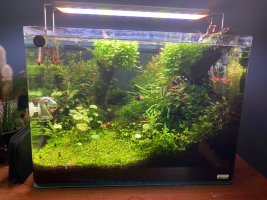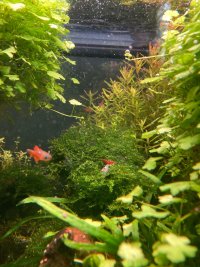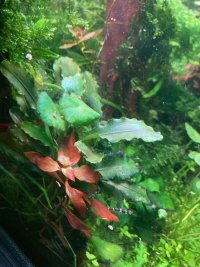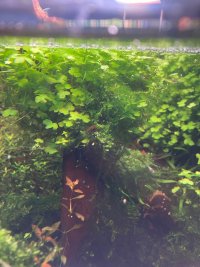I'm a bit confused by everything and annoyed I didn't know about the power sand vs everything else.
There’s nothing here to be confused by, nor worth getting annoyed about. We acquire knowledge on the basis we have a need for it in a hobby - it’s fun! Also a never ending journey which we should be grateful for, it keeps us interested.
All the different means of delivery are just tools
@Saman . Picking the tool for the job assumes you knew what you wanted upfront, on your very first aquascape no less. Unlikely to be the case. Desires change as things tick along. You’re considering doing the other tank soon so maybe an opportunity to try another method on the second tank 🤔 Learn all methods, all the benefits and the downsides.
Presuming you want a better understanding of the intention of Powersand so will continue to head in that direction.
Powersand advanced - screened pumice with no sharp edges, peat, additives that promote the breakdown of humic substances (bacter 100), leads to humic acids and humates creating an acidic environment, phosphate in abundance.
For our intents and purposes look up ‘dystrophic lakes’. Wiki page will do. That’s what this layer intends to deliver. The phosphate is readily available for fresh roots with excess being picked up by the aquarium soil above and bacter 100 is simply food for bacteria to speed up the process of achieving a mature substrate. It’s not 100 types of bacteria in a bottle as the BS marketing states, it’s material that encourages the types of bacteria that are supposed to be beneficial in all sorts of functions from the get go. The peat clears up your water, hence why ADA can claim it increases water clarity at startup; this is linked to having a substrate that allows flow through it (baked clay balls and bits of pumice for structure) with the potential for oxygenated water to travel through the substrate.
Take money/brand/argument out of the equation and you have: a means for expediting substrate maturity, phosphate availability from the substrate, a mechanism for breaking down matter into micro nutrients (both binding toxic forms that plants haven’t used up that could be dangerous to your livestock in the early days and replenishing availability of micronutrients from the substrate from organic breakdown), a substrate that allows water to travel through it with the potential for oxygenated water to reach deeper for a more complex biome.
So what this means for the end user is we can get away with just a potassium source such as K2SO4 and a meagre amount of micros in the water column daily. It’s more prone to success at startup using a prescribed dosing system and lighting without any control (on/off with fixed PAR and tank dimensions).
Is Powersand Advance the be all and end all? No.
It’s just an easily marketed product that hedges the bet that things will work out if the consumer empties their wallet to let someone else do the thinking. It still works though… so not snake oil from this perspective but you’ve paid for someone else to do the thinking. Having N and P predominantly available from the substrate let’s you run a leaner water column under higher lighting = pretty colours.
I imagine it's the soil running out of nutrients but then you can just flip over to the other method. I'm wondering if I can boost things in my tank with root tabs...
You’re ahead of the game
@Saman this is music to the ears. Human beings are great at empiricism if we want to observe thoroughly, honestly and without ego. Good luck with the current state of affairs as everyone would have you believe it’s picture perfect all the time. That’s not to say it can’t be, but the wisest gardeners know what to do, when to do it and how this may lead to downsides in the longer run.
For example, Pogostemon erectus loves being root fed with a lean water column, soft water, low KH, high light (200 PAR plus in the top six inches of depth) with minimal competition at the roots. This is exampled by the broadest leaves with yellow and green colouration that is robust to algal problems. The downside is if you don’t tear it out, thin it out and force it to produce new rooting occasionally it’s root system is so thick and extensive, everything around it suffers under the ADA method. Other things don’t appreciate root tabs placed directly underneath them, Rotala wallichii for example. As a hobbyist you’re simply looking for a causative model and monitoring the outcome and looking for repeated results. Mentioned controlling your input water earlier as it benefits consistency when we’re learning.
With the h'ra, do you think it would be beneficial to replant it given the bottom half of the plant has yellow and speckled leaves and the top half looks strong and healthy? I cut it down every week but it occurred to me yesterday that I'm always cutting off the nicest bits. I could just replant the top halves. The roots are very well established though...
General rule of thumb… let it top out (hit the surface three times) then it’s time to cut and replant the tops. It’s a fast and loose rule as during startup you may want to double plant mass - cut halfway, replant the tops and leave the rooted growth. It’s actually a lot more as the nodes will put out fresh stems, then you’re down to thinning out and replanting what is required.
been thinking about what you said about the ADA system - power sand & needing less CO2 and I've had a look at a few journals that use this approach. To me this seems like the easier way to go about things and I wish I'd gone down this road.
Free yourself. EI has its use, ADA method has its use, midpoint of the two has its use. Both may be appropriate at different times within the same month for one reason or another… But understand what Co2 input does and what effects it has on everything else. For all this waffle, the takeaway is simply what keeps the most diverse biome for the longest stretch of time? This forum is a rich tapestry of honest folks reporting what they are doing to the best of their ability and what the outcomes that were observable were.
Just a thought… why does everyone put Powersand everywhere across the footprint when setting up rather than in select places in a scape where distribution might be an issue under lean dosing? Yet to see a carpeting species that anyone wanted going more rampant 😂







